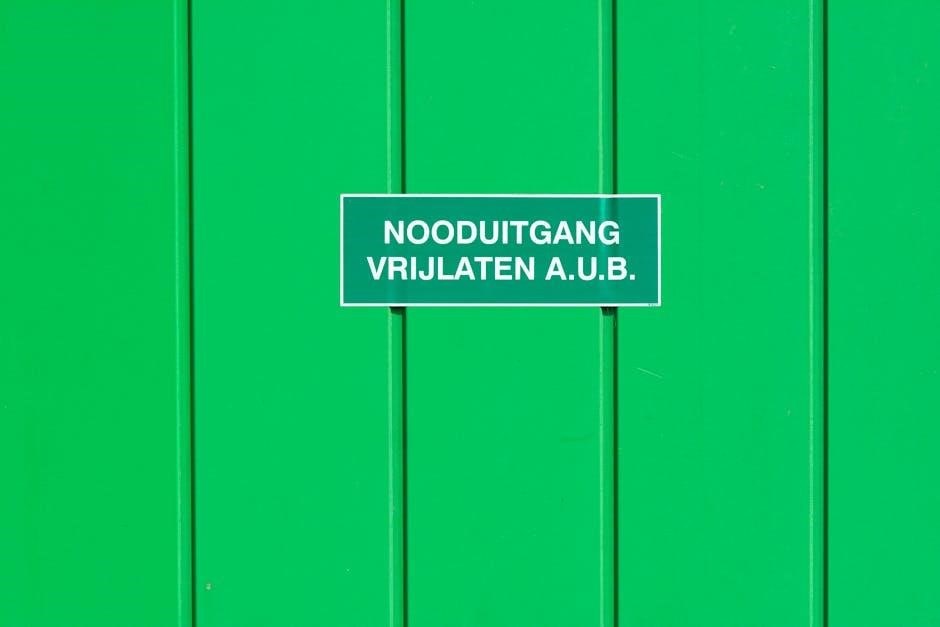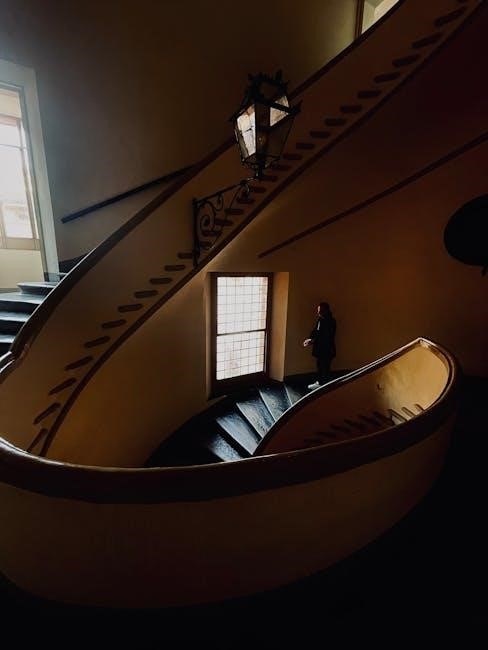Architect lettering is a cornerstone in architectural communication, ensuring precision and clarity in design representation. It has evolved from hand-drawn styles to digital formats, maintaining its essential role in conveying ideas effectively. This guide explores its fundamentals, historical context, and modern applications, helping you master the art of architectural lettering.
1.1 What is Architect Lettering?
Architect lettering refers to the specialized writing style used by architects to ensure clarity and precision in architectural drawings and documents. It involves the use of specific lettering techniques to convey information effectively. Traditionally done by hand, modern practices often employ digital tools to maintain consistency and legibility, making it an essential skill for clear communication in architecture.
1.2 Importance of Lettering in Architecture
Architectural lettering plays a vital role in ensuring clear communication of designs. It enhances readability, maintains consistency, and contributes to a professional presentation. Clear lettering helps convey complex ideas effectively, making it easier for architects, engineers, and clients to collaborate. Proper lettering is essential for precise documentation, aiding in successful project execution and maintaining design integrity.

Tools and Materials for Architect Lettering
Essential tools include technical pens, pencils, graph paper, and digital software like AutoCAD and Adobe Illustrator. These resources enable precision, creativity, and professional architectural documentation.
2.1 Essential Tools for Hand Lettering
For hand lettering, essential tools include technical pens, fine-tip pencils, erasers, and graph paper. Technical pens ensure consistent line widths, while pencils allow for sketches and adjustments. Graph paper aids in maintaining scale and alignment. Additional tools like rulers and sharpeners enhance precision and neatness, enabling architects to create clear, professional, and visually appealing lettering in their designs and documentation.
2.2 Digital Tools for Architectural Lettering
Digital tools like AutoCAD and Adobe Illustrator revolutionize architectural lettering, offering precision and scalability. AutoCAD excels in creating vector-based lettering with exact measurements, while Illustrator enables creative typography. Other tools like SketchUp and Inkscape provide versatility for custom designs. These platforms enhance efficiency, allowing architects to produce consistent, high-quality lettering that integrates seamlessly with overall design schemes and meets modern aesthetic demands.

Basic Techniques of Architect Lettering
Balancing creativity and technical precision, architectural lettering requires mastering line weights, letter formation, spacing, and alignment. Consistency ensures professional, readable designs.
3.1 Understanding Line Weights and Styles
Line weights and styles are crucial in architectural lettering, enhancing readability and visual hierarchy. Varying line thickness creates emphasis, while consistent styles ensure uniformity. Thin lines are used for details, medium for primary elements, and bold for headers. Mastering these techniques ensures professional and effective communication in architectural designs.
3.2 Mastering Alphabet Formation
Mastering alphabet formation is key to architectural lettering. Practice consistent letter spacing, alignment, and proportions. Use guides or grids to ensure accuracy. Pay attention to serif and sans-serif styles, as they impact readability. Regular practice enhances muscle memory, enabling precise and uniform lettering. This skill is foundational for clear communication in architectural designs and documentation.

Best Practices for Architectural Lettering
Adhere to established guidelines for consistency and readability, using grids to ensure uniformity and balance aesthetics with functionality for effective communication in architectural designs.
4.1 Consistency in Lettering
Consistency is key to professional architectural lettering, ensuring clarity and readability. Use uniform lettering styles, sizes, and spacing across all elements. Architects often use specific fonts like “architect print” for uniformity. Employ grids or digital tools like AutoCAD or Adobe Illustrator to maintain precision. Consistency ensures designs look cohesive and communicate ideas effectively, blending aesthetics with functionality seamlessly.
4.2 Readability and Clarity
Readability and clarity are vital in architectural lettering to ensure designs are easily understood. Use clean lines, legible fonts, and proper spacing. Tools like grids help maintain alignment and consistency. Avoid unnecessary embellishments that might distract from the message. Clear lettering communicates ideas effectively, enhancing both aesthetic and functional aspects of architectural designs.
Common Architectural Lettering Styles
Architectural lettering styles range from modern sans-serif to traditional serif. Popular styles include Gothic, Roman, and script fonts, each offering unique aesthetic and functional benefits for designs.
5.1 Gothic Lettering in Architecture
Gothic lettering in architecture is characterized by its vertical lines and pointed arches, evoking a sense of tradition and grandeur. Originating in medieval times, it is often used in historical and religious designs for its aesthetic appeal and legibility. This style is popular in monumental inscriptions, blending seamlessly with traditional architectural elements while maintaining a timeless and sophisticated appearance.
5.2 Modern Sans-Serif Lettering
Modern sans-serif lettering is characterized by clean, minimalist lines and the absence of serifs, offering a sleek and contemporary aesthetic. Its simplicity enhances readability, making it ideal for modern architectural designs; This style is widely used in signage, blueprints, and digital interfaces, aligning with minimalist trends in architecture and ensuring clarity in communication. Its versatility suits both physical and digital mediums seamlessly.

Advanced Tips for Architect Lettering
Mastering grids ensures precision, while experimenting with digital tools enhances creativity. Maintain consistency, balance detail with simplicity, and refine spacing for optimal readability in architectural designs.
6.1 Using Grids for Precision
Grids are essential for achieving accuracy in architect lettering. They help maintain consistent alignment, spacing, and proportions. By using horizontal and vertical guides, you can ensure letters and symbols are evenly spaced and properly aligned. Start with a light grid sketch or use digital tools with grid features to enhance precision and create professional-looking lettering effortlessly.
6.2 Incorporating Symbols and Glyphs
Incorporating symbols and glyphs enhances architectural lettering by adding context and visual interest. Use them sparingly to avoid clutter, ensuring they complement the text. Digital tools allow precise customization, while hand-drawn glyphs can add a personal touch. Consistency is key; ensure symbols align with the overall design and maintain readability, providing clear visual cues for better comprehension and engagement.

Digital Software for Architect Lettering
Digital software like AutoCAD and Adobe Illustrator revolutionizes architect lettering by offering precision, scalability, and customization. These tools enhance consistency and creativity in architectural design documentation.
7.1 AutoCAD for Lettering
AutoCAD is a powerful tool for architectural lettering, offering precision and customization. It supports custom fonts, layer organization, and dimensioning tools, ensuring consistency and readability. Its scalability and integration with design elements make it ideal for architectural documentation, enhancing professionalism and clarity in communication.
7.2 Adobe Illustrator for Vector Lettering
Adobe Illustrator excels in vector lettering, offering unparalleled precision and scalability. Its powerful tools, like the Pen and Shape Builder, enable intricate font design. Architects can manipulate letterforms freely, ensuring consistency and readability. Illustrator’s ability to edit individual characters and adjust spacing makes it ideal for custom architectural typography, enhancing the visual appeal of blueprints and design documentation.

Historical Context of Architect Lettering
Architectural lettering traces its roots to ancient civilizations, evolving through historical styles like Roman inscriptions and Gothic scripts. Its development reflects cultural shifts and technological advancements, shaping modern practices.
8.1 Evolution of Architectural Lettering
Architectural lettering has evolved from ancient inscriptions to modern digital formats, influenced by historical styles like Roman typography and Gothic scripts. The Middle Ages saw intricate calligraphy, while the Renaissance brought proportionality and elegance. The Industrial Revolution introduced standardized fonts, and digital tools now enable precise, customizable lettering, blending tradition with innovation for contemporary design needs.
8.2 Influence of Historical Architectural Styles
Historical architectural styles, such as Roman, Gothic, and Renaissance, have deeply influenced lettering in architecture. Roman serifs were used for monumental inscriptions, while Gothic styles favored intricate, elongated forms. The Renaissance revived classical proportions, inspiring elegant lettering. These historical influences continue to shape contemporary architectural lettering, blending tradition with modern design principles to create visually striking and meaningful compositions.

Modern Trends in Architect Lettering
Historical architectural styles have significantly influenced architectural lettering. Roman architecture utilized serif fonts for monumental inscriptions, emphasizing strength and permanence. Gothic styles introduced elongated and intricate letterforms, reflecting the era’s ornate designs. The Renaissance brought a revival of classical proportions, leading to more elegant and balanced lettering. These historical influences continue to inspire contemporary architectural lettering, blending tradition with modern aesthetics.
9.1 Minimalist Lettering in Contemporary Design
Minimalist lettering has become a key trend in contemporary architecture, emphasizing simplicity and clean lines. This style uses sans-serif fonts and streamlined shapes to ensure readability and functionality. By stripping away ornate details, minimalist lettering aligns with modern design principles, creating a sleek, uncluttered aesthetic that complements the overall architectural vision. Its focus on clarity makes it ideal for digital applications and urban spaces.
9.2 Sustainability in Architectural Lettering
Sustainability in architectural lettering involves using eco-friendly materials and practices. Digital tools reduce the need for physical resources, while traditional methods opt for recycled paper and biodegradable inks. Modern software, like AutoCAD and Adobe Illustrator, supports energy-efficient workflows. These practices ensure minimal environmental impact without compromising design quality, aligning with contemporary architectural values and promoting a greener future in design communication.

Common Mistakes to Avoid
Common mistakes include overcomplicating designs, ignoring spacing, and inconsistent lettering styles. Ensuring clarity and readability is crucial. Avoid poor alignment and improper tool usage for professional results.
10.1 Overcomplicating Designs
Overcomplicating designs can lead to cluttered and illegible lettering, distracting from the primary message. Avoid excessive embellishments or intricate details that hinder readability. Simplify your approach to ensure clarity and focus on essential elements. Use clean lines and balanced proportions to maintain professionalism and effectiveness in architectural communication.
10.2 Ignoring Spacing and Alignment
Ignoring spacing and alignment can lead to visually unbalanced and hard-to-read lettering. Proper spacing ensures readability, while alignment maintains a professional appearance. Uneven or inconsistent spacing can create confusion, making designs look amateurish. Always use grids or alignment tools to keep your lettering organized and visually appealing, ensuring clarity and coherence in your architectural designs.

Resources for Learning Architect Lettering
Discover recommended books, tutorials, and online communities to master architectural lettering. Utilize forums, workshops, and digital tools to enhance your skills and stay updated with design trends.
11.1 Recommended Books and Tutorials
Explore essential resources like “Architectural Drawing” by David Dernie and “Lettering for Architects” by Steven Heller. Online platforms such as Skillshare and Coursera offer tutorials on architectural lettering. These resources provide hands-on exercises, historical insights, and modern techniques to refine your skills in creating precise and aesthetically pleasing lettering for architectural designs and presentations.
11.2 Online Communities and Forums
Join online communities like Reddit’s r/Architecture and r/GraphicDesign, or specialized forums on architecture and design websites. These platforms offer valuable resources, feedback, and networking opportunities. Engage with professionals, share your work, and stay updated on the latest trends in architectural lettering. Participating in these forums can enhance your learning and help you refine your skills through collaborative discussions and shared knowledge.
Mastering architect lettering requires practice, patience, and adherence to best practices. By combining traditional techniques with modern tools, you can create precise, visually appealing designs that communicate effectively.
12.1 Final Tips for Mastering Architect Lettering
Consistency, precision, and creativity are key to mastering architect lettering. Practice regularly, combining traditional techniques with digital tools like AutoCAD and Adobe Illustrator. Pay attention to spacing, alignment, and legibility. Experiment with modern trends while respecting historical influences. Embrace minimalist designs and sustainable practices to enhance your work. Stay curious and continuously refine your skills for exceptional results.
12.2 The Future of Architect Lettering
The future of architect lettering lies in blending traditional techniques with advanced digital tools. As technology evolves, lettering will become more integrated with augmented reality and AI, enhancing design precision. Sustainability will drive innovations in materials and software. Embrace adaptability and continuously explore new tools and styles to stay ahead in this dynamic field.




About the author